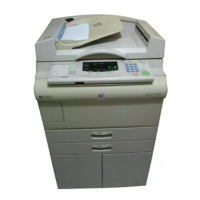The transfer wheels have two slots [A] in them 180 degrees apart. As the
transfer wheels turn, these slots engage the pins of the bins and lift them up.
Each time the transfer wheels turn 180 degrees, they raise one bin.
The CPU counts the bins using the wheel sensor [B]. This sensor monitors
the movement of the wheel drive motor as well. When one of the slots on the
cylindrical actuator [C] passes the sensor, the sensor is deactivated and the
wheel drive motor turns off.
To move the bins down, the CPU reverses the wheel drive motor and the
above process reverses.
The bin home position sensor [D] is located at the lower rear end of the
sorter. When all the bins are lowered, the lift bar [E] presses down on the
actuator [F], actuating the sensor. The CPU checks the sensor whenever the
power is turned on. At this time, if the bins are not in the home position, the
home position sensor is deactuated and the CPU will return the sorter bins to
the home position.
The mounting position is about 18.5 degrees off between the front transfer
wheel [G], and the rear transfer wheel [H]. Therefore, the front and rear of
the bins do not rise simultaneously, thus preventing unusual noise and
reducing load. Also, the shape of the transfer wheels has been modified from
previous models to reduce banding on copies that is caused by vertical
slippage due to the movement of the sorter bins.
Old Wheel Shape New Wheel Shape
[A]
[D]
[F]
[E]
[C]
[B]
[H]
[G]
Sorter
A556
STM 8-9 A156/A160/A162

